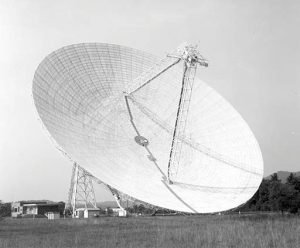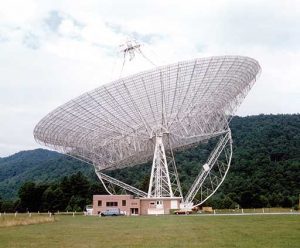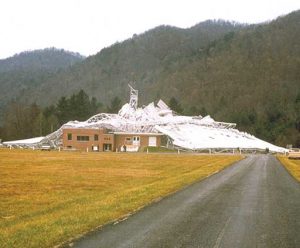
In the early days of the NRAO, the late 1950s, eager American radio astronomers wanted a giant radio telescope to call their own. In the design stages was a most ambitious plan for the world’s largest equatorially-mounted telescope, a 140-foot monster dish. However, its never-before-attempted engineering would take some time…a little too much time, and anxious astronomers sought a “quick and dirty” big telescope to span the wait.
Largest Transit Telescope
In offices still new-smelling from the NRAO’s inauguration, radio astronomers and contracted engineers discussed plans for a 300-foot transit telescope, a behemoth that could observe the sky turning overhead. Engineer E. R. Faelten of Buffalo, New York took the designs to fabricators for proposals on building the new telescope.
In April 1961, the Bristol Steel and Iron Works, Inc. was awarded the contract, and we enjoyed a groundbreaking ceremony with them on April 27, 1961. By August 30, 1962, they had completed the construction of what became the world’s largest radio telescope from designs that had left desks less than two years before.
What they built was an aluminum mesh-covered dish atop a spiderweb of steel trusswork on a geared rocker that allowed the 300-foot wide dish to tilt north and south. The telescope observed cosmic radio sources by riding the Earth turning underneath them, bringing them into its field of view for about 40 seconds. The receiver feeds of the 300-foot were on a small mount that drove against the Earth’s direction of spin, letting them track cosmic radio sources for a few extra minutes of observing time before the spinning Earth dragged the telescope too far out from underneath the source.
Science at the 300-foot
At 12:42 am on September 21, the 300-foot telescope observed for the first time. With Frank Drake and George Grove at the controls of the world’s largest moving telescope, it observed Tycho’s supernova remnant, an expanding shell of gas from a star that exploded on the 11th of November, 1572.
During its first year of operations, this giant telescope observed many more supernova remnants, giving us a much more detailed look at the collection of elements that had been made inside stars.
The 300-foot also examined stellar nurseries, complex gas and molecule-rich nebulae where stars are formed. These included the nearest region to us, the Orion Nebula found in the sword of the Orion constellation, and the enormous Rosette Nebula in the Large Magellanic Cloud dwarf galaxy that orbits our giant spiral galaxy, the Milky Way.
Tracking gas clouds in other galaxies is a means of tracking the galaxies themselves, like getting a radar snapshot of a license plate on a speeding car. The 300-foot tracked the movement toward or away from it of blobs of hydrogen in galaxies, including our own. Plots of speed-grouped hydrogen clouds in our Galaxy traced the arms of the Milky Way and discovered that its outer spiral disk is warped. Astronomers’ plots of the locations of galaxies helped trace the shape of the Universe.
The discovery of dark matter was helped along by the 300-foot’s observations of hydrogen in spiral galaxies. When the 300-foot telescope observed galaxies, it saw invisible gas extending farther out than the visible galaxy – the galaxy was much larger than it appeared to optical telescopes. And, because the 300-foot could record the speed of the gas, it saw a galaxy’s outer regions spinning just about as fast as their middle regions. What is shoving those outer arms so fast? The only way modern physics can answer that question is if even more matter resides in the galaxy than either radio or optical telescopes can detect. The theory of an unseen type of matter was born, thanks to the 300-foot’s observations.
Before the 300-foot telescope, we didn’t know that pulsars come from supernova explosions. Aiming the 300-foot at the supernova remnant known as the Crab Nebula in 1968, astronomers Staelin and Reifenstein discovered that the radio waves coming from the point inside the Nebula was not constant but pulsed. Eureka! Supernovas cause pulsars.
This monumental telescope observed other weird objects that vary their radio signals over time, such as flaring stars.
One of the most important products to come out of the 300-foot telescope was an all-sky survey of radio objects called the Green Bank 6cm Survey. Nearly every northern hemisphere radio object studied by any other telescope is from a catalog compiled using this telescope.
Major Upgrades

In 1970, the 300-foot’s surface had become so warped from maintenance crews, snow, and its own weight that a new finer-meshed aluminum surface was installed.
A larger traveling feed was also installed at the prime focus.
In 1971, the 300-foot’s building was doubled in size with the addition of a Faraday-caged control room with new electronics.
Collapse
The final first for this telescope is that it famously collapsed at 9:43 pm on November 15, 1988.
According to Greg Monk, the telescope operator in the building below the telescope, he heard a crack and “a low rumble like an overhead jet aircraft” before a chunk of steel pierced the ceiling, smashed the toilet, and wiped out power to all of the lights. He dodged the buckling ceiling to hit the telescope’s emergency stop, but he left the data recorder running. He then fled the building to get help — in his van that had also been pierced by steel.
The scientists and engineers who came to help could do nothing: the telescope was a mangled pile of steel. Descriptions ranged from looking “like a rotted mushroom that had collapsed” to “like a big steamship … capsized and the spires sticking up in the air” and “more like caramel than steel.”

Calmly and professionally, but teary-eyed, staff protected the computers with plastic, secured the building, and preserved the last of the 300-foot’s data. When these data were reviewed, astronomers noted that an increase in the size of the telescope’s precision beam showed that the dish had in fact been ripping open slowly for a few days. The last seconds of the data traced the fall of the receiver on to the roof of the control building.
What caused the world’s largest moving telescope to collapse? Independent investigators discovered that unforeseeable stress factors cracked a steel connector plate that just happened to be a key but hidden member of the support structure of the giant telescope. No one was to blame, and no one was hurt – but one of radio astronomy’s greatest telescopes was gone.
By June of 1989, the metal was being hauled off to scrapyards. However, pieces of the famous wire mesh were kept and are on display in the Green Bank Science Center in West Virginia.
Stats of the 300-foot Telescope
- Reflector: 300-foot diameter dish made from aluminum Squarex mesh; 78,000 square feet (1.8 acre) collecting area
- Surface accuracy: ~1 inch
- Max height: 240 feet or roughly that of a 23-storey building
- Weight: 600 tons, moving weight of 500 tons
- Could withstand 65mph winds and 400 tons of snow
- Drive Rate: 10° of arc per minute
- Pointing accuracy: ~2 minutes of arc
- Some of the first receivers on the 300-foot telescope were the 21 cm (1420 MHz), 40 cm (750 MHz) , 75 cm (408 MHz), and 128 cm (234 MHz) single-beam receivers.
- The 4-feed 1400 MHz (21 cm wavelength) survey receiver was completed around 1968 and made several continuum sky surveys up until around 1980.
- In the early 1970s the 300-foot was upgraded to work at wavelengths as short as 6 cm, and a dual-beam 6 cm receiver was built for it around 1972.
- For the famous Green Bank All Sky Survey, Jim Condon had a 7-feed 4.85 GHz receiver built to do a sky survey in the mid 1980’s. Legend says that it is this famous survey that broke the telescope!
In the News
There were no posts found.

